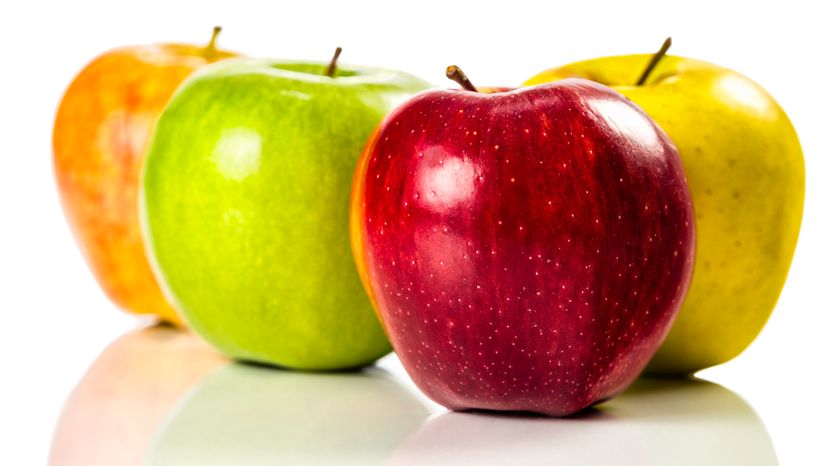Let's take a look at the stars of the sweet apple world and explore what makes each of them uniquely delightful. We've listed these varieties in alphabetical order for easy perusal.
1. Ambrosia Apples
Ambrosia was the staple diet on Mount Olympus, according to Greek mythology, and the apple doesn't fall far from the tree in that regard. The ambrosia apple is sweet and tender, with a delightful hint of honey flavor and a crisp texture — fit for gods!
Discovered as a chance seedling in British Columbia, Canada, Ambrosias have quickly gained popularity for their honeyed sweetness and beautiful pink-red color.
2. Cripps Pink Apples
Cripps Pink apples are often confused with Pink Lady, but they are actually the broader variety name. Pink Ladies are a specific type of Cripps Pink apples.
These fruits are sweet and crunchy. Their firmness and unique taste make them perfect for baking, holding their shape well in pies and tarts. You can also eat them fresh, of course.
3. Envy Apples
Envy apples are a cross between Royal Gala and Braeburn apples. Their vibrant red and yellow skin makes them as much a feast for the eyes as the taste buds. They pair wonderfully with cheese and charcuterie boards.
4. Fuji Apples
Originating from Japan in the late 1930s, Fuji apples are renowned for their super sweet flavor and crunchy texture, making them a top choice for both snacking and baking. Horticulturists created these apples by crossing the Red Delicious and Ralls Janet varieties.
With their juicy bite and floral notes, Fuji apples are a testament to how crossbreeding can lead to sweetness perfection.
5. Gala Apples
Gala apples are sweet and aromatic. They've got a little hint of vanilla and are crisp as can be. Originating from New Zealand, they're a cross between Kidd's Orange Red and Golden Delicious apples. Galas have a beautiful red-orange hue, making them a favorite in fruit salads and lunchboxes.
6. Golden Delicious Apples
The Golden Delicious apple is a timeless classic. It's big, tough and sweet in equal measure. Hailing from the country roads of West Virginia, these fruits are great for snacking and cooking alike. Their sweetness mellows out when baked, so it's a great choice for pies and sauces.
If you're looking for an apple that balances sweetness with a subtle hint of tartness, Golden Delicious is a go-to.
7. Honeycrisp Apples
Known for its explosive juiciness and sweet-tart flavor, the Honeycrisp apple offers a texture that's both crunchy and refreshing.
Developed by the University of Minnesota in the 1960s, this apple has become synonymous with apple pies and fall baking. Its complex flavor profile ensures every bite is a symphony of sweet and tangy goodness.
8. McIntosh Apples
McIntosh apples are a little softer to bite into than a lot of other options on this list. They're also right on the cusp between sweet and tart. They're a staple in a lot of applesauce recipes, since their tender flesh breaks down easily when cooked.
Apple, the computer company, named their Macintosh computers after these apples — but they changed the name to avoid copyright issues with McIntosh Laboratory.
9. Pink Lady Apples
The Pink Lady apple is sweet and tangy, with just a hint of berry flavor. Developed in Australia, this apple's vibrant pink skin and lively taste make it stand out from the crowd. Its firm flesh and balanced sweetness make it a great choice for fresh eating, baking and adding a pop of color to any dish.
10. Red Delicious Apples
If you see a student put an apple on a teacher's desk in a movie, odds are it's the instantly recognizable Red Delicious. While it may not be the absolute sweetest on our list, its popularity stems from its classic apple flavor and bright red visual appeal.
Eat these ones fresh if you're in the mood for some no-frills, back-to-basics, straightforward sweetness.
